KPackageKit/da: Difference between revisions
(Created page with 'Hvis du kender pakkens navn så skal du blot skrive dette i ''søgelinjen'' - som standard søges der efter navn.') |
(Created page with '{{Note/da|Søgning går langsomt, da pakkedatabasen skal tilgås - både din lokale kopi og databasen for hvert arkiv. Du vil opdage, at arbejdet går langsomt mens dette står p...') |
||
| Line 20: | Line 20: | ||
Hvis du kender pakkens navn så skal du blot skrive dette i ''søgelinjen'' - som standard søges der efter navn. | Hvis du kender pakkens navn så skal du blot skrive dette i ''søgelinjen'' - som standard søges der efter navn. | ||
{{Note| | {{Note/da|Søgning går langsomt, da pakkedatabasen skal tilgås - både din lokale kopi og databasen for hvert arkiv. Du vil opdage, at arbejdet går langsomt mens dette står på.}} | ||
Suppose, though, you need suggestions for suitable packages. This time you would choose to <menuchoice>Find by Description</menuchoice>. For instance, entering "flaac" into the search term then selecting <menuchoice>Find by Description</menuchoice> you would be presented with all packages that are related to the use of flaac files. Installed packages show a grey X (which will be used if you need to remove something) and available packages have a grey down-arrow. | Suppose, though, you need suggestions for suitable packages. This time you would choose to <menuchoice>Find by Description</menuchoice>. For instance, entering "flaac" into the search term then selecting <menuchoice>Find by Description</menuchoice> you would be presented with all packages that are related to the use of flaac files. Installed packages show a grey X (which will be used if you need to remove something) and available packages have a grey down-arrow. | ||
Revision as of 15:20, 14 September 2010
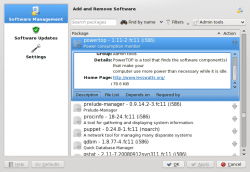 |
Et grafisk værktøj til at håndtere dine pakker |
Hovedtræk
- Manages installation and un-installation of packages
- Manages package updates
- Can be searched by package-name, description, or included file name
- Supports filtering on
- Installed or available
- Free or non-free
- End-user or development
- Graphical or text-only
- Can be viewed in package groups
Installing packages
Hvis du kender pakkens navn så skal du blot skrive dette i søgelinjen - som standard søges der efter navn.
Suppose, though, you need suggestions for suitable packages. This time you would choose to . For instance, entering "flaac" into the search term then selecting you would be presented with all packages that are related to the use of flaac files. Installed packages show a grey X (which will be used if you need to remove something) and available packages have a grey down-arrow.
So - you have a list of suitable files. Click on one of them and a panel opens giving you a description of the file. (Enlarge the image above to see this, then use your browser's button to return here.) There are three other options to display - a list of files included in the package, a list of dependencies (which will be automatically handled if you choose to install)
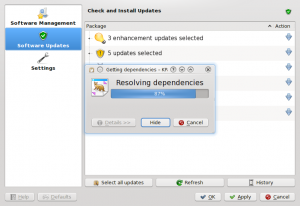
and a list of applications that depend upon the package you choose.
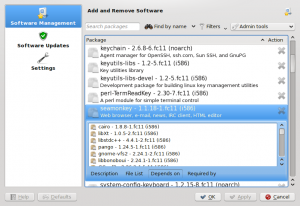
Having found the application that is best for you, click on the down-arrow and you will see both the package icon and the action icon become active. Click OK, and your package will be installed.
Updating your packages
The second section lists any packages for which updates are available. As before, the repos and your installation are queried, so there is a delay. When the list is created, it is presented in groups.
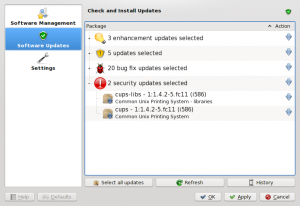
Again, dependencies are resolved when you agree to the download.
Configuration Options
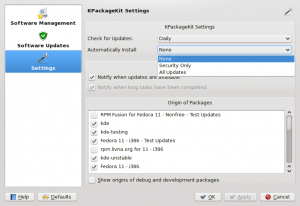
The third and final section of KPackageKit is the page. Here you can set the frequency of checking for updates, according to your need. The default is , but for an ultra-secure site you could choose Hourly, and for a lightly used one you can have or frequency.
Next is whether you want updates to be installed automatically. A nice touch is to be able to say that security updates should be automatically installed, but no other packages.
The next choice is whether you want the tray icon to notify you of available updates, and whether it should tell you when large jobs are finished.
The final section lists all the repos you have set up. Here you can enable or disable individual repos.
The Tray Icon
Finally, the tray icon can give you some information while your install or upgrade is progressing.

Here you can see the progress of your batch of updates or installs. A simple hover over the icon gives you a percentage reading of the job.

